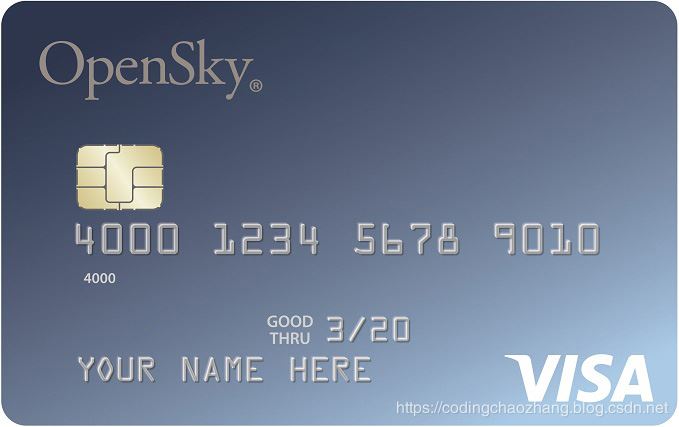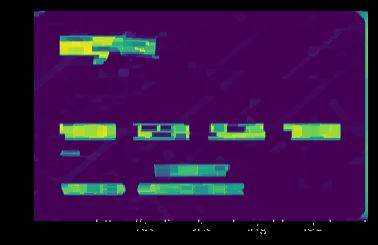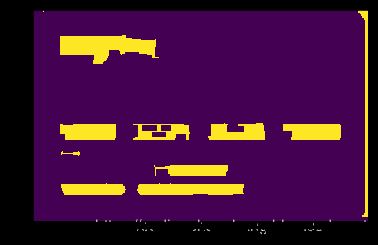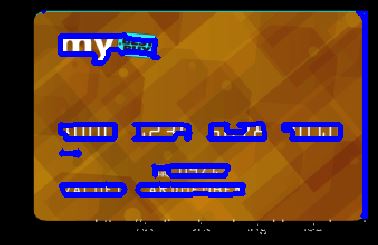本項目利用python以及opencv實現信用卡的數字識別
前期準備
- 導入工具包
- 定義功能函數
模板圖像處理
- 讀取模板圖像 cv2.imread(img)
- 灰度化處理 cv2.cvtColor(img,cv2.COLOR_BGR2GRAY)
- 二值化 cv2.threshold()
- 輪廓 - 輪廓
信用卡圖像處理
- 讀取信用卡圖像 cv2.imread(img)
- 灰度化處理 cv2.cvtColor(img,cv2.COLOR_BGR2GRAY)
- 禮帽處理 cv2.morphologyEx(gray,cv2.MORPH_TOPHAT,rectKernel)
- Sobel邊緣檢測 cv2.Sobel(tophat, ddepth=cv2.CV_32F, dx=1, dy=0, ksize=-1)
- 閉操作 cv2.morphologyEx(gradX, cv2.MORPH_CLOSE, rectKernel)
- 計算輪廓 cv2.findContours
- 模板檢測 cv2.matchTemplate(roi, digitROI,cv2.TM_CCOEFF)
原始數據展示






結果展示

1 前期準備
|
1
2
3
4
5
6
7
8
|
# 導入工具包# opencv讀取圖片的格式為b g r# matplotlib圖片的格式為 r g bimport numpy as npimport cv2from imutils import contoursimport matplotlib.pyplot as plt%matplotlib inline |
|
1
2
3
4
|
# 信用卡的位置predict_card = "images/credit_card_01.png"# 模板的位置template = "images/ocr_a_reference.png" |
|
1
2
3
4
5
6
7
|
# 指定信用卡類型FIRST_NUMBER = { "3": "American Express", "4": "Visa", "5": "MasterCard", "6": "Discover Card"} |
|
1
2
3
4
5
6
7
8
9
10
11
12
13
14
15
16
17
18
19
20
21
22
23
24
25
26
27
28
29
30
31
32
33
34
35
36
37
38
|
# 定義一些功能函數# 對框進行排序def sort_contours(cnts, method="left-to-right"): reverse = False i = 0 if method == "right-to-left" or method == "bottom-to-top": reverse = True if method == "top-to-bottom" or method == "bottom-to-top": i = 1 boundingBoxes = [cv2.boundingRect(c) for c in cnts] #用一個最小的矩形,把找到的形狀包起來x,y,h,w (cnts, boundingBoxes) = zip(*sorted(zip(cnts, boundingBoxes), key=lambda b: b[1][i], reverse=reverse)) return cnts, boundingBoxes# 調整圖片尺寸大小def resize(image, width=None, height=None, inter=cv2.INTER_AREA): dim = None (h, w) = image.shape[:2] if width is None and height is None: return image if width is None: r = height / float(h) dim = (int(w * r), height) else: r = width / float(w) dim = (width, int(h * r)) resized = cv2.resize(image, dim, interpolation=inter) return resized# 定義cv2展示函數def cv_show(name,img): cv2.imshow(name,img) cv2.waitKey(0) cv2.destroyAllWindows() |
2 對模板圖像進行預處理操作
讀取模板圖像
|
1
2
3
4
|
# 讀取模板圖像img = cv2.imread(template)cv_show("img",img)plt.imshow(img) |
|
1
|
<matplotlib.image.AxesImage at 0x2b2e04ad128> |

模板圖像轉灰度圖像
|
1
2
3
4
|
# 轉灰度圖ref = cv2.cvtColor(img,cv2.COLOR_BGR2GRAY)cv_show("ref",ref)plt.imshow(ref) |
|
1
|
<matplotlib.image.AxesImage at 0x2b2e25d9e48> |

轉為二值圖像
|
1
2
3
|
ref = cv2.threshold(ref,10,255,cv2.THRESH_BINARY_INV)[1]cv_show("ref",ref)plt.imshow(ref) |
|
1
|
<matplotlib.image.AxesImage at 0x2b2e2832a90> |

計算輪廓
|
1
2
3
4
5
6
7
8
|
#cv2.findContours()函數接受的參數為二值圖,即黑白的(不是灰度圖),cv2.RETR_EXTERNAL只檢測外輪廓,cv2.CHAIN_APPROX_SIMPLE只保留終點坐標#返回的list中每個元素都是圖像中的一個輪廓# 在二值化后的圖像中計算輪廓refCnts,hierarchy = cv2.findContours(ref.copy(),cv2.RETR_EXTERNAL,cv2.CHAIN_APPROX_SIMPLE)# 在原圖上畫出輪廓cv2.drawContours(img,refCnts,-1,(0,0,255),3)cv_show("img",img)plt.imshow(img) |
|
1
|
<matplotlib.image.AxesImage at 0x2b2e256f908> |

|
1
2
3
4
5
6
7
8
9
10
11
12
13
14
|
print(np.array(refCnts).shape)# 排序,從左到右,從上到下refCnts = sort_contours(refCnts,method="left-to-right")[0] digits = {}# 遍歷每一個輪廓for (i, c) in enumerate(refCnts): # 計算外接矩形并且resize成合適大小 (x, y, w, h) = cv2.boundingRect(c) roi = ref[y:y + h, x:x + w] roi = cv2.resize(roi, (57, 88)) # 每一個數字對應每一個模板 digits[i] = roi |
(10,)
3 對信用卡進行處理
初始化卷積核
|
1
2
|
rectKernel = cv2.getStructuringElement(cv2.MORPH_RECT, (9, 3))sqKernel = cv2.getStructuringElement(cv2.MORPH_RECT, (5, 5)) |
讀取信用卡
|
1
2
3
|
image = cv2.imread(predict_card)cv_show("image",image)plt.imshow(image) |
|
1
|
<matplotlib.image.AxesImage at 0x2b2e294c9b0> |

對圖像進行預處理操作
|
1
2
3
4
5
6
|
# 先對圖像進行resize操作image = resize(image,width=300)# 灰度化處理gray = cv2.cvtColor(image,cv2.COLOR_BGR2GRAY)cv_show("gray",gray)plt.imshow(gray) |
|
1
|
<matplotlib.image.AxesImage at 0x2b2e255d828> |

對圖像禮帽操作
- 禮帽 = 原始輸入-開運算結果
- 開運算:先腐蝕,再膨脹
- 突出更明亮的區域
|
1
2
3
|
tophat = cv2.morphologyEx(gray,cv2.MORPH_TOPHAT,rectKernel)cv_show("tophat",tophat)plt.imshow(tophat) |
|
1
|
<matplotlib.image.AxesImage at 0x2b2eb008e48> |

用Sobel算子邊緣檢測
|
1
2
3
4
5
6
7
8
|
gradX = cv2.Sobel(tophat, ddepth=cv2.CV_32F, dx=1, dy=0, ksize=-1)gradX = np.absolute(gradX)(minVal, maxVal) = (np.min(gradX), np.max(gradX))gradX = (255 * ((gradX - minVal) / (maxVal - minVal)))gradX = gradX.astype("uint8")print (np.array(gradX).shape)cv_show("gradX",gradX)plt.imshow(gradX) |
|
1
2
|
(189, 300)<matplotlib.image.AxesImage at 0x2b2e0797400> |

對圖像閉操作
- 閉操作:先膨脹,再腐蝕
- 可以將數字連在一起
|
1
2
3
|
gradX = cv2.morphologyEx(gradX, cv2.MORPH_CLOSE, rectKernel) cv_show("gradX",gradX)plt.imshow(gradX) |
|
1
|
<matplotlib.image.AxesImage at 0x2b2e097cc88> |

|
1
2
3
4
|
#THRESH_OTSU會自動尋找合適的閾值,適合雙峰,需把閾值參數設置為0thresh = cv2.threshold(gradX, 0, 255,cv2.THRESH_BINARY | cv2.THRESH_OTSU)[1] cv_show("thresh",thresh)plt.imshow(thresh) |
|
1
|
<matplotlib.image.AxesImage at 0x2b2e24a0dd8> |

|
1
2
3
4
|
# 再進行一次閉操作thresh = cv2.morphologyEx(thresh, cv2.MORPH_CLOSE, sqKernel) #再來一個閉操作cv_show("thresh",thresh)plt.imshow(thresh) |
|
1
|
<matplotlib.image.AxesImage at 0x2b2e25fe748> |

計算輪廓
|
1
2
3
4
5
6
|
threshCnts, hierarchy = cv2.findContours(thresh.copy(), cv2.RETR_EXTERNAL,cv2.CHAIN_APPROX_SIMPLE)cnts = threshCntscur_img = image.copy()cv2.drawContours(cur_img,cnts,-1,(0,0,255),3) cv_show("img",cur_img)plt.imshow(cur_img) |
|
1
|
<matplotlib.image.AxesImage at 0x2b2eb17c780> |

|
1
2
3
4
5
6
7
8
9
10
11
12
13
14
15
16
17
|
locs = []# 遍歷輪廓for (i, c) in enumerate(cnts): # 計算矩形 (x, y, w, h) = cv2.boundingRect(c) ar = w / float(h) # 選擇合適的區域,根據實際任務來,這里的基本都是四個數字一組 if ar > 2.5 and ar < 4.0: if (w > 40 and w < 55) and (h > 10 and h < 20): #符合的留下來 locs.append((x, y, w, h))# 將符合的輪廓從左到右排序locs = sorted(locs, key=lambda x:x[0])output = [] |
模板匹配
|
1
2
3
4
5
6
7
8
9
10
11
12
13
14
15
16
17
18
19
20
21
22
23
24
25
26
27
28
29
30
31
32
33
34
35
36
37
38
39
40
41
42
43
44
|
# 遍歷每一個輪廓中的數字for (i, (gX, gY, gW, gH)) in enumerate(locs): # initialize the list of group digits groupOutput = [] # 根據坐標提取每一個組 group = gray[gY - 5:gY + gH + 5, gX - 5:gX + gW + 5] cv_show("group",group) # 預處理 group = cv2.threshold(group, 0, 255,cv2.THRESH_BINARY | cv2.THRESH_OTSU)[1] cv_show("group",group) # 計算每一組的輪廓 digitCnts,hierarchy = cv2.findContours(group.copy(), cv2.RETR_EXTERNAL,cv2.CHAIN_APPROX_SIMPLE) digitCnts = contours.sort_contours(digitCnts,method="left-to-right")[0] # 計算每一組中的每一個數值 for c in digitCnts: # 找到當前數值的輪廓,resize成合適的的大小 (x, y, w, h) = cv2.boundingRect(c) roi = group[y:y + h, x:x + w] roi = cv2.resize(roi, (57, 88)) cv_show("roi",roi) # 計算匹配得分 scores = [] # 在模板中計算每一個得分 for (digit, digitROI) in digits.items(): # 模板匹配 result = cv2.matchTemplate(roi, digitROI,cv2.TM_CCOEFF) (_, score, _, _) = cv2.minMaxLoc(result) scores.append(score) # 得到最合適的數字 groupOutput.append(str(np.argmax(scores))) # 畫出來 cv2.rectangle(image, (gX - 5, gY - 5),(gX + gW + 5, gY + gH + 5), (0, 0, 255), 1) cv2.putText(image, "".join(groupOutput), (gX, gY - 15),cv2.FONT_HERSHEY_SIMPLEX, 0.65, (0, 0, 255), 2) # 得到結果 output.extend(groupOutput) |
|
1
2
3
4
5
|
# 打印結果print("Credit Card Type: {}".format(FIRST_NUMBER[output[0]]))print("Credit Card #: {}".format("".join(output)))cv_show("Image",image)plt.imshow(image) |
|
1
2
3
4
5
6
7
8
|
Credit Card Type: VisaCredit Card #: 4000123456789010<matplotlib.image.AxesImage at 0x2b2eb040748> |

以上就是本文的全部內容,希望對大家的學習有所幫助,也希望大家多多支持服務器之家。
原文鏈接:https://blog.csdn.net/Mind_programmonkey/article/details/99650303












